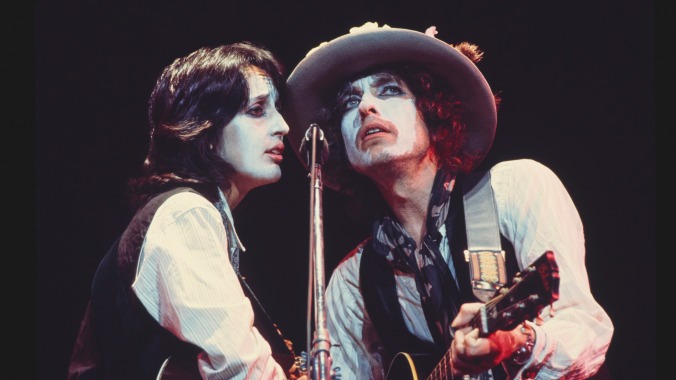Martin Scorsese digs up a lost Bob Dylan tour in the slippery Netflix concert film Rolling Thunder


In 1975, Bob Dylan, who’d just started touring again following an eight-year hiatus (ostensibly precipitated by his infamous motorcycle accident), decided to put together something a bit unconventional. Rather than simply play concerts, he’d headline a “revue,” accompanied by a rotating group of fellow musicians (Joan Baez, Ramblin’ Jack Elliott, Joni Mitchell, Roger McGuinn, Mick Ronson, etc.), a poet laureate (Allen Ginsberg), a screenwriter (Sam Shepard) for an accompanying film project, and a cameraman (Howard Alk) to shoot material both onstage and behind the scenes. Some of this footage wound up in Dylan’s poorly received quasi-narrative directorial debut, Renaldo And Clara (1978). The rest of it sat in a vault for decades, until Martin Scorsese—who’d previously made a mammoth documentary, No Direction Home (2005), recounting Dylan’s transition from Woody Guthrie-style troubadour to electrified “Judas”—dug it out and assembled it into something semi-coherent. But Scorsese also decided to add an element of his own, one that transforms the film from historically significant afterthought to slightly perplexing myth.
It’s unclear how many of Rolling Thunder’s 57 shows (over two legs, in fall 1975 and spring 1976) Alk filmed. Most of the concert footage appears to come from just one, and focuses almost exclusively on Dylan (sometimes dueting with Baez), performing songs from Desire—the 1976 album he recorded with the same backing band—as well as blistering rock-and-roll arrangements of folk-era classics like “A Hard Rain’s A-Gonna Fall.” Scorsese might have wanted to avoid a cavalcade-of-stars approach, which would closely resemble his 1978 concert doc The Last Waltz (in which Dylan also performs), though it seems more likely that many of the supporting acts just didn’t get filmed. But while the tour’s “revue” aspect largely gets lost, Dylan himself is a wheel on fire, all but snarling into the microphone from beneath the white face paint he wore most nights, apparently as a glam-influenced mask. Indeed, Rolling Thunder’s primary frustration is that Scorsese repeatedly cuts away mid-song in order to contextualize what we’re seeing with talking-head interviews (including a rare contemporary sit-down with Dylan himself). The film is strongest when simply observing these legendary performances, largely unseen for four long decades.
It’s weakest, on the other hand, when needlessly yanking the viewer’s chain. Rolling Thunder Revue sports the subtitle A Bob Dylan Story By Martin Scorsese, which might seem a tad overblown given that all of the archival footage—which is to say, most of the movie—was shot by somebody else, without Scorsese’s contemporaneous involvement. Perhaps by way of acknowledging this, Scorsese invents a tour filmmaker, Stefan van Dorp (Martin von Haselberg), who appears in present-day interviews complaining about the degree to which his contribution is being undervalued. There’s no onscreen indication that Van Dorp is fictional, however—only true diehards who know Alk’s name and history (he died in 1982) will have any reason to be suspicious—so the joke feels weirdly esoteric. What’s more, it’s not limited to Van Dorp. So far, everyone involved with the film is being very cagey about how much of what we see has no basis in reality, but there’s reason to doubt that the young Sharon Stone briefly worked on the tour (and mistakenly thought that Dylan had written “Just Like A Woman” for her), while fans of Robert Altman’s miniseries Tanner ’88 will definitely recognize an ostensible politician played by Michael Murphy.
Apparently, the idea behind these fictional interludes is that they represent Dylan’s prankish side—he was known to falsify his personal background, claiming to be from New Mexico rather than Minnesota, and makes a point of noting here, when asked about his facepaint, that someone wearing a mask is more inclined to be truthful. In this particular context, however, such playfulness merely registers as a distraction (and a retroactive distraction at that, for most viewers, who will only learn about the prank by reading reviews like this one). There’s too much arresting authenticity here for creative fiction to gain any real purchase, or even to have much of a point. In addition to the onstage footage, Alk captured some truly amazing candid moments, several of them involving Joni Mitchell: We see her teaching Dylan and McGuinn the riff to “Coyote” (then a brand-new song) during a casual jam session, and joining a large group in an impromptu rendition of “Love Potion No. 9" on the tour bus. Compared to living history like that, celebrities feigning a connection to same seems cute at best, a waste of our time at worst. Maybe it would have been more effective had Scorsese Spinal Tapped it up a little bit, such that almost anyone would intuit the presence of monkey business. Played this straight, it’s mostly footnote material.
Ultimately, the copious, unmanipulated (one hopes!) footage of Dylan himself is what will endure. As is always the case, he is this project’s true auteur, and it’s fitting that the film concludes with a truly startling rundown of literally every day he’s spent on the road since kicking off the Rolling Thunder Revue—which is to say, over the majority of his adult life. There have been no hiatuses since.